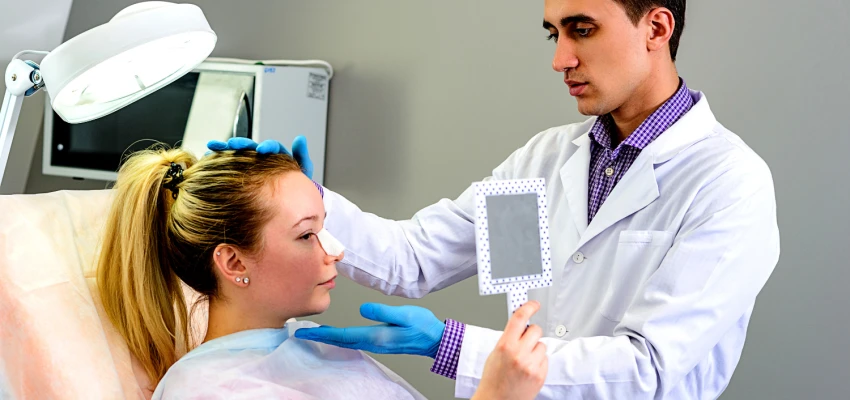
Difference Between Open and Closed Rhinoplasty: Pros and Cons
Rhinoplasty, commonly known as a nose job, is a popular cosmetic procedure that aims to enhance the appearance and functionality of the nose. If you're considering rhinoplasty, you may have come across two terms: open rhinoplasty and closed rhinoplasty. In this blog post, we'll explore the key differences between these two techniques, including the pros and cons, patient experiences, recovery, aftercare, and cost comparison. By the end, you'll have a better understanding of which approach may be suitable for you.
Overview: Open and Closed Rhinoplasty
Open and closed rhinoplasty are the two main surgical techniques used in nose reshaping. In open rhinoplasty, a small incision is made on the columella, the strip of tissue that separates the nostrils. This approach allows the surgeon greater visibility and maneuverability during the procedure. It's often recommended for more complex cases, as it facilitates extensive reshaping.
On the other hand, closed rhinoplasty involves incisions made within the nostrils, leaving no visible scarring on the outside of the nose. This technique is typically used for simpler cases, where minor adjustments are required. The surgeon operates through the nostril openings, which can be more challenging due to the limited visibility compared to open rhinoplasty.
Both techniques have their advantages and disadvantages, and the choice between the two often depends on the surgeon's expertise and the specific needs and goals of the patient.
Open Rhinoplasty
Open rhinoplasty is a surgical technique that involves creating an external incision across the columella, the strip of tissue between the nostrils. This allows the surgeon better visibility and access to the nasal structures. Let's take a closer look at the pros and cons of open rhinoplasty.
Pros of Open Rhinoplasty:
- Greater precision in reshaping the nasal structures
- Improved access for complex revisions or extensive corrections
- Better visualization of the nasal anatomy for the surgeon
Cons of Open Rhinoplasty:
- Longer surgery time and increased swelling compared to closed rhinoplasty
- Potential for a visible scar on the columella, although it typically fades over time
- Slightly longer recovery period compared to closed rhinoplasty
Patient Experiences: Many patients who have undergone open rhinoplasty report satisfaction with the level of precision and correction achieved. They appreciate the improved access for complex revisions, resulting in refined and natural-looking outcomes.
Looking for a Rhinoplasty in Turkey?
Explore Turkish healthcare professionals at a fraction of the cost. Get a quote for free!
Closed Rhinoplasty
Closed rhinoplasty, also known as endonasal rhinoplasty, is a technique where all incisions are made internally, within the nostrils. This approach is suitable for less complex cases that require minimal modifications to the nasal structures.
Pros of Closed Rhinoplasty:
- No visible external scarring
- Less swelling and shorter recovery time compared to open rhinoplasty
- Suitable for cases where less extensive modifications are required
Cons of Closed Rhinoplasty:
- Limited visibility for the surgeon, making certain corrections more challenging
- Less access to complex revisions or extensive reshaping
- Potential for less predictable outcomes in certain cases
Patient Experiences: Patients who have opted for closed rhinoplasty appreciate the shorter recovery time and lack of external scarring. While it may not be suitable for all cases, closed rhinoplasty can still achieve beautiful and satisfying results.
Recovery and Aftercare
Both open and closed rhinoplasty require proper care and attention during the recovery phase. It's important to follow your surgeon's instructions to ensure optimal healing. Some general tips for a smooth recovery include:
- Taking prescribed medications as directed
- Keeping the surgical area clean and protected
- Avoiding strenuous activities and heavy lifting
- Following a recommended diet for optimal healing
Interested in Nose Job?
Cost Comparison: Turkey vs Abroad
The cost of rhinoplasty can vary depending on several factors, including the surgeon's experience, geographic location, and the complexity of the procedure. Generally, open rhinoplasty tends to be slightly more expensive than closed rhinoplasty due to the increased surgical time and complexity.
In Turkey, the average cost of rhinoplasty ranges from $3,000 to $5,000. However, internationally, the cost can be higher, ranging from $5,000 to $15,000 or more, depending on the country and specific circumstances.
It's important to consult with a qualified and experienced plastic surgeon who can assess your specific needs and provide an accurate cost estimate based on your unique case.
Conclusion
Choosing between open and closed rhinoplasty depends on various factors, including the complexity of your case, desired outcomes, and the recommendations of your surgeon. Open rhinoplasty offers greater access and precision, while closed rhinoplasty provides a shorter recovery time and no visible external scarring.
When considering rhinoplasty, it's crucial to consult with a reputable and experienced plastic surgeon who can guide you through the decision-making process based on your individual needs and goals.
Remember, every patient is unique, and what works for one person may not be the best choice for another. By understanding the differences, pros, cons, and patient experiences of open and closed rhinoplasty, you'll be better equipped to make an informed decision and achieve the results you desire.
Always prioritize your safety and well-being, and consult with a qualified professional to ensure the best possible outcome for your rhinoplasty journey.
Disclaimer: This document is intended to provide general information about rhinoplasty and does not constitute professional medical advice, diagnosis, or treatment of any kind. Always seek the advice of your physician or other qualified health provider with any questions you may have regarding a medical procedure. Never disregard professional medical advice or delay in seeking it because of something you have read in this document. Individual results may vary and cannot be guaranteed.
Last updated: 26.04.2024
